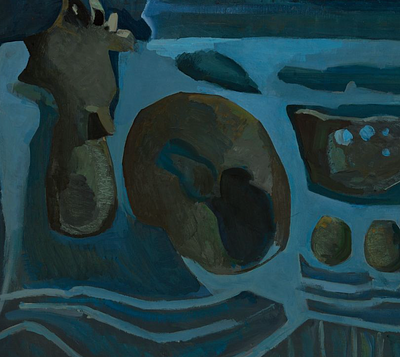TEAM 57 (Paris, 1957-1962). "Composition", 1957. Gouache on paper.
Lot 102
About Seller
Setdart Auction House
Carrer Aragó 346
Barcelona
Spain
Setdart Subastas was born in 2004 and is currently the first online art auction in Spain with solidity, prestige and reliability guaranteed by our more than 60,000 users. Setdart has a young, dynamic and enterprising team ready to successfully manage the purchase and sale of art works through custom...Read more
Categories
Estimate:
EUR€10,000 - EUR€12,000
$10,416.67 - $12,500
Absentee vs Live bid
Two ways to bid:
- Leave a max absentee bid and the platform will bid on your behalf up to your maximum bid during the live auction.
- Bid live during the auction and your bids will be submitted real-time to the auctioneer.
Bid Increments
| Price | Bid Increment |
|---|---|
| EUR€0 | EUR€10 |
| EUR€200 | EUR€25 |
| EUR€500 | EUR€50 |
| EUR€1,000 | EUR€100 |
| EUR€3,000 | EUR€200 |
| EUR€5,000 | EUR€500 |
| EUR€10,000 | EUR€1,000 |
| EUR€20,000 | EUR€2,000 |
| EUR€50,000 | EUR€5,000 |
About Auction
By Setdart Auction House
Jul 27, 2021
Set Reminder
2021-07-27 08:00:00
2021-07-27 08:00:00
America/New_York
Bidsquare
Bidsquare : CONTEMPORARY AND ACTUAL ART
https://www.bidsquare.com/auctions/setdart-auction-house/contemporary-and-actual-art-7261
Setdart Auction House sofia@setdart.com
Setdart Auction House sofia@setdart.com
- Lot Description
TEAM 57 (Paris, 1957-1962). "Composition", 1957. Gouache on paper. Presents several labels on the back; Carmen Aranguren Gallery, Rafael Ortiz Gallery, Guillermo de Osma Gallery, Cisne Gallery, Marita Segovia Gallery. Size: 28 x 28 cm; 53 x 53 cm (frame). This work stems from a manifesto created by the artistic group in 1957. In this document they defined their artistic purposes, based on a very specific plastic theory, which tried to vindicate the role of art in society. The piece stands out for an aesthetic in which there is a clear importance of geometric elements, which dominate the composition, and have been executed and arranged in such a way that they do not transmit a spatial sensation, but a flat one whose purpose is to compose an image that gathers and interprets the aesthetic values of Russian constructivism, analytical geometry, and dynamism, through a clear and synthetic language. Equipo 57 was formed in 1957 by three painters and two architects: Agustín Ibarrola, Ángel Duarte and José Duarte, on the one hand, and Juan Cuenca and Juan Serrano on the other. Later the Danish Thorkild Hansen joined the group. The first objective of the group was to take advantage of the new resources and machinery of the moment to apply them to industrial design and architecture, leaving aside any intention of authorship or individualism. With the interest of showing an art of collective character that would connect with the viewer in a global way and not based on localisms or individualities. They sought to change the social reality through the transformation of the everyday environment, through a language inherited from constructivism, where geometric shapes, color and attraction have a great prominence. It is not surprising the adoption of this aesthetic language due to the political circumstances of the country. In which Franco's dictatorship offered an official art based on tradition and popular stereotypes. For this reason Equipo 57 was an artistic milestone in the country, not only because of the aesthetics, as already mentioned, but also because of the adoption of techniques and a system of work based on the collective, following the same trends that were occurring in other countries, as in the example of the CoBRA group. Their activities, contemporary to those of the groups El Paso and Dau al Set, although very different aesthetically and theoretically, represented the maximum example of radical geometric abstraction in Spain, with works marked by planes of uniform color that dialogue with each other, both in painting and sculpture. The group also published numerous theoretical texts, always keeping in mind the change in society, and therefore sought alternative means to bring their ideas to a wide audience. Thus, they sold their works at affordable prices, trying to break the elitist character of art, and distanced themselves from art dealers and galleries. In fact, they declared themselves against them and also against the official organizations related to public instruction. This, as well as the radical nature of their aesthetic stance and, above all, their clear opposition to the Franco regime, meant that their work did not achieve success. In fact, his production will not be recovered until the nineties, when his pioneering role in the history of Spanish art will be vindicated through an important anthological exhibition held at the Reina Sofia Museum (1993). That same year, 1993, the group was awarded the Gold Medal of Fine Arts.
- Shipping Info
-
In-house shipping available. Please inquire at admin@setdart.com.
-
- Buyer's Premium



 EUR
EUR CAD
CAD AUD
AUD GBP
GBP MXN
MXN HKD
HKD CNY
CNY MYR
MYR SEK
SEK SGD
SGD CHF
CHF THB
THB

















